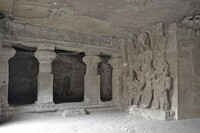| dc.coverage.spatial | Site: Elephanta Island, Mahārāshtra, India | en_US |
| dc.coverage.temporal | ca. 535-550 (creation) | en_US |
| dc.creator | unknown (Indian (South Asian)) | en_US |
| dc.date | 535-550 | en_US |
| dc.date.accessioned | 2016-06-21T19:10:59Z | |
| dc.date.available | 2016-06-21T19:10:59Z | |
| dc.date.issued | 535-550 | en_US |
| dc.identifier | 264772 | en_US |
| dc.identifier.other | archrefid: 3412 | en_US |
| dc.identifier.uri | http://hdl.handle.net/1721.3/180830 | |
| dc.description | East wing, looking towards east chamber with dvarapala flanked by attendant demons; The name Elephanta is derived from a stone elephant, removed (with other sculptures) to Mumbai. There are two groups of caves; the first is a large group of five Hindu (Brahmanical) caves, the second, a smaller group of two Buddhist caves. The Hindu caves contain rock-cut sculptures, representing the Shaiva Hindu sect, dedicated to the Lord Shiva. Cave 1 (the Great Cave), the finest, is unusual in that it is cut into the rock from three different sides. The eastern and western breaches lead to courts that have entrances to the pillared hall of the main shrine. The patronage and date of the caves are a subject of debate. Iconographic and stylistic considerations suggest the monument was made for the Pashupata sect, probably in the second quarter of the 6th century. Cave 1 blends Chalukyan architectural features such as massive figures of the divinities, guardians, and square pillars with custom capitals with Gupta artistic characteristics, like the depiction of mountains and clouds and female hairstyles. A UNESCO World Heritage Site. Source: Grove Art Online; http://www.oxfordartonline.com/ (accessed 8/2/2015) | en_US |
| dc.format.medium | basalt rock | en_US |
| dc.rights | © Scott Gilchrist, Archivision, Inc. | en_US |
| dc.subject | architecture | en_US |
| dc.subject | deities | en_US |
| dc.subject | Hinduism | en_US |
| dc.subject | Shavite | en_US |
| dc.subject | Chalukyan | en_US |
| dc.subject | Gupta | en_US |
| dc.title | Elephanta Caves: Cave 1 | en_US |
| dc.title.alternative | Gharapurichi Leni: Cave 1 | en_US |
| dc.type | image | en_US |
| dc.rights.access | Licensed for educational and research use by the MIT community only | en_US |
| dc.identifier.vendorcode | 1A2-IN-M-EI-A46 | en_US |
| vra.culturalContext | Indian (South Asian) | en_US |
| vra.technique | carving (processes) | en_US |
| vra.worktype | shrine (structure) | en_US |
| vra.worktype | rock-cut temple | en_US |
| vra.worktype | sculpture (visual work) | en_US |
| dc.contributor.display | unknown (Indian (South Asian)) | en_US |

